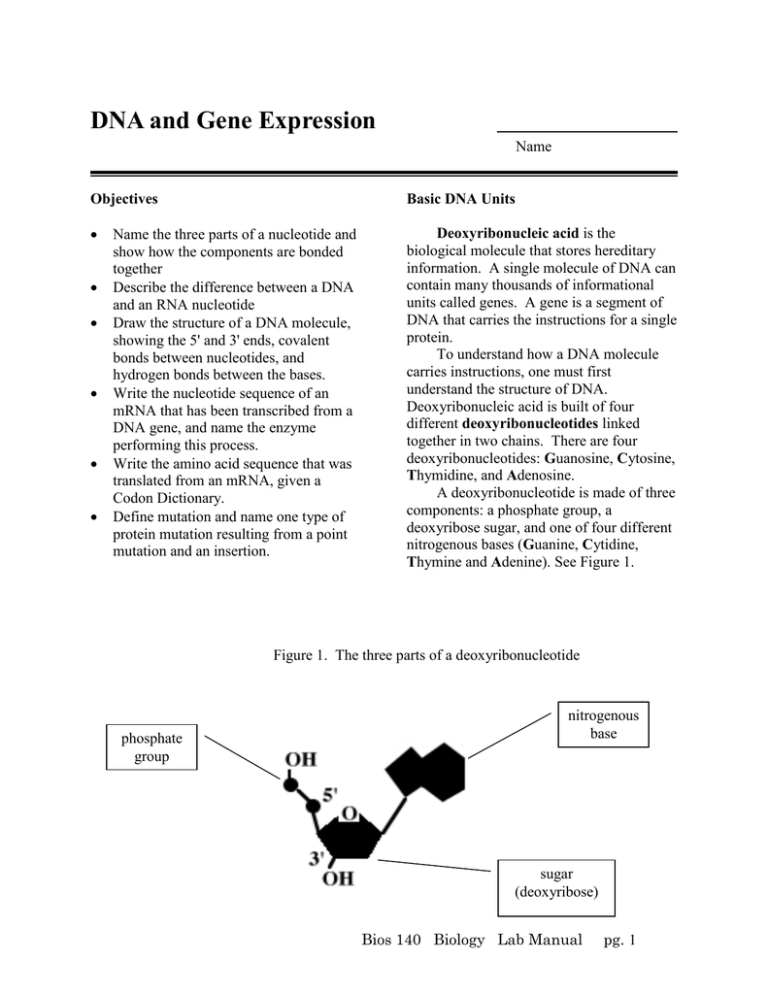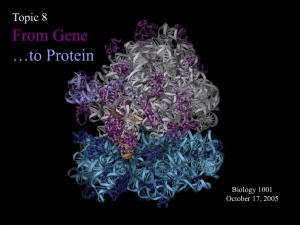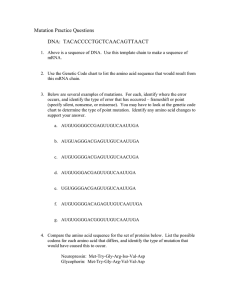DNA and Gene Expression
advertisement

DNA and Gene Expression Name Objectives Basic DNA Units Deoxyribonucleic acid is the biological molecule that stores hereditary information. A single molecule of DNA can contain many thousands of informational units called genes. A gene is a segment of DNA that carries the instructions for a single protein. To understand how a DNA molecule carries instructions, one must first understand the structure of DNA. Deoxyribonucleic acid is built of four different deoxyribonucleotides linked together in two chains. There are four deoxyribonucleotides: Guanosine, Cytosine, Thymidine, and Adenosine. A deoxyribonucleotide is made of three components: a phosphate group, a deoxyribose sugar, and one of four different nitrogenous bases (Guanine, Cytidine, Thymine and Adenine). See Figure 1. Name the three parts of a nucleotide and show how the components are bonded together Describe the difference between a DNA and an RNA nucleotide Draw the structure of a DNA molecule, showing the 5' and 3' ends, covalent bonds between nucleotides, and hydrogen bonds between the bases. Write the nucleotide sequence of an mRNA that has been transcribed from a DNA gene, and name the enzyme performing this process. Write the amino acid sequence that was translated from an mRNA, given a Codon Dictionary. Define mutation and name one type of protein mutation resulting from a point mutation and an insertion. Figure 1. The three parts of a deoxyribonucleotide phosphate group nitrogenous base sugar (deoxyribose) Bios 140 Biology Lab Manual pg. 1 DNA is made in the cell by linking the DNA-type nucleotides together. The linkage occurs between the "3' OH" of the sugar part of one nucleotide and the "5' OH" of the phosphate group on another. 1. In Figure 2 below, draw a line between the "O" of the "3' OH" on the upper nucleotide down to the black ball just under the "OH" of the lower nucleotide. This line represents the covalent bond that forms during the linking reaction of deoxyribonucleotides. In making DNA, two chains of deoxyribonucleotides are formed and then linked together. The nucleotide Adenine forms hydrogen bonds with Thymine, and Cytosine bonds with Guanine. The two chains of DNA run in opposite directions, and so are called antiparallel. 1. Working with a partner, get a set of DNA nucleotides and build a single strand of nucleotides. You should begin with the 5' end of the first nucleotide turned sideways to your left and build on new nucleotides to the right. The nucleotides should be built using the following sequence: CGATGTACTCGTGAC and should look something like this on the desktop (but with different nucleotides): Figure 2. Two deoxyribonucleotides 2. Double check that you’ve laid down the DNA nucleotides so that the dashed lines (hydrogen bonds) are facing upwards and the 5’ P groups have lines that connect fully with the 3’ carbon of the adjacent nucleotide’s sugar. Put the 5’ end at your left. The DNA Molecule A full DNA molecule is composed of two chains of deoxyribonucleotides held together by hydrogen bonds between the nitrogenous bases. 3. Next, build the opposite strand of DNA, using the correct nucleotides to make pairs with the nucleotides in the first strand. Remember, Adenine bonds with Thymine (A-T) and Guanine bonds with Cytosine (G-C) Build the second strand over the top of the existing strand, in a right to left direction. This means you begin adding nucleotides opposite the end of the existing strand that Bios 140 Biology Lab Manual pg. 2 reads CAGTG etc. The two strands should show connections like this (note the dashed hydrogen bonds holding the nucleotides together in the middle): 4. The ends of each of the two strands can be labeled 5' or 3' based on which part of the nucleotide is left hanging out. Label the ends of the DNA molecule below to reflect how your DNA is built as it lays in front of you. Do the two strands have different labels at the same end? They should. build a specific protein, the gene sequence must first be transcribed (copied). Transcription of a gene involves the opening of the DNA helix by the breaking of hydrogen bonds between the bases. The RNA polymerase enzyme then reads the nucleotide sequence on one of the two strands of DNA, called the template. The non-template strand is not read. RNA polymerase builds a complementary molecule of messenger RNA as it reads the template strand. The complementary mRNA molecule has matching, not identical, ribonucleotides to the DNA sequence. RNA, or ribonucleic acid, is different from DNA in that it contains ribose sugar, not deoxyribose. It also contains the nitrogenous bases: Adenine, Uracil, Guanine, and Cytosine. Uracil replaces thymine in RNA, but it still pairs with adenine using hydrogen bonds. 1. Working with a partner, open the DNA strands of your desktop DNA molecule by breaking the hydrogen bonds between the bases and separating them a bit. As you do this, you are simulating the action of a molecule machine (enzyme) called RNA polymerase. Transcription 2. Using the RNA nucleotides provided (they are a different color than DNA nucleotides), make a complementary or matching copy of the template strand of the DNA. The template strand is the one that reads from the 5' end: GTCAC…..etc. You therefore need to place matching RNA nucleotides next to the template strand, "U" by a DNA "A", "A" by a DNA "T", "G" by a DNA "C", and "C" by a DNA "G". A gene is a sequence of DNA nucleotides that carry the information to build a single protein or protein. In order to 3. You are playing the part of RNA polymerase when you transcribe a DNA gene into mRNA. This enzyme lays 5. How many hydrogen bonds (dashed lines) are there between adenine and thymine? 6. How many hydrogen bonds are there between guanine and cytosine? Bios 140 Biology Lab Manual pg. 3 down new RNA in a 5’ to 3’ direction. The mRNA made from the template strand is antiparallel to the template strand. Therefore, your mRNA should read from the 5’ end: CGAU, etc. if you are doing this correctly. Table I. mRNA codons and the amino acids (abbreviated) they specify Translation Once a gene has been transcribed into messenger RNA, the next step is to build a protein from these RNA instructions. In prokaryotes like bacteria, the protein building "machine", or ribosome, is nearby. In eukaryotic cells, the mRNA must first leave the nucleus and enter the cytoplasm to encounter a ribosome. Translation is the process whereby a ribosome reads the mRNA nucleotide sequence and builds a protein from these instructions. Building a protein involves linking specific amino acids together by peptide bonds. Amino acids are brought to the ribosome by transporting molecules called transfer RNAs, or tRNAs. A ribosome is composed of two bloblike units containing over 50 different proteins plus two or three pieces of nucleic acid called ribosomal RNA. Together these proteins and RNA molecules are capable of reading the genetic code on the mRNA, positioning the amino acids, and forming peptide bonds between them, one at a time. The mRNA directs the ribosome to place specific amino acids in a specific ordered sequence based the three-letter "code words" or codons . The ribosome begins reading the mRNA at the 5' end and only starts building a protein when it reads a start codon, or AUG. According to Table I, what amino acid is always used to start a protein? When the ribosome reads a stop codon on the messenger RNA, translation is complete. According to Table I, what are the three stop codons? , , and . Transfer RNA molecules bring amino acids to the ribosome, one by one, according to the codon instructions. As each tRNA enters the ribosome, the mRNA codon is matched with a specific sequence or "sign" found at the bottom of each tRNA. This "sign" is called an anticodon. The anticodon of the tRNA must be the complementary match to the mRNA codon before the ribosome will accept the amino acid the tRNA is carrying. 1. Examine the transfer RNA (shaped like a cloverleaf) in Figure 3 which is carrying an amino acid. Locate the anticodon and the hydrogen bonds between the anticodon and the codon. 2. The RNA nucleotides that make up the mRNA codon are missing. Fill in the missing complementary/matching bases on the mRNA that would match pair with the nucleotides of the anticodon. Bios 140 Biology Lab Manual pg. 4 3. Looking at the Codon Dictionary in Table I, determine which amino acid the tRNA pictured in Figure 3 is carrying. The amino acid is: Figure 3. The anticodon of a transfer RNA molecule can form hydrogen bonds with a codon on the messenger RNA. read the names of the nucleotides sequentially until you discover the sequence AUG. These three bases together are known as a Start Codon, and they instruct the ribosome to place the amino acid Methionine first in all proteins. Get a Methionine amino acid card and place it next to the AUG codon. 3. Next, read the series of three nucleotides (the next codon) immediate following the AUG. Use the RNA Codon Dictionary (Table I) to determine what amino acid is specified by this codon. Get this amino acid card and place it (link it) next to the methionine amino acid card. 4. Continue building your protein chain by reading the subsequent codons and laying down the appropriate amino acids. 5. At some point you will arrive at a codon whose instruction is "Stop". This type of codon (there are three) is called a Stop Codon. When this codon is read by the ribosome, the protein is finished. No further amino acids are added, even if there are more unread nucleotides in the mRNA. Translation 1. With the available collection of all 20 amino acids, translate the messenger RNA you made earlier into a protein. The ribosome translates mRNA from the 5’ to the 3’ end. Be sure you build your protein by reading the mRNA in the correct direction! 6. Write the sequence of all the amino acids chained together in your protein, using the three-letter abbreviations for each. Begin with Met (methionine). 2. Begin by starting at the 5' end of your messenger RNA. Don't clear away your DNA molecule yet because you will still need it later. Beginning at the 5' end, Bios 140 Biology Lab Manual pg. 5 Mutation A mutation is a permanent, heritable change in the DNA. Mutation occurs naturally, but rarely, whenever DNA is being made. Mutation also occurs when mutagenic agents such as ultraviolet light, cigarette smoke, X-rays, or formaldehyde cause alterations in the DNA. When the nucleotide sequence in a gene is altered, the messenger RNA made from this gene has an altered sequence. The resultant effect on the amino acid sequence of the protein can be disastrous or neutral. A point mutation is a change in a single nucleotide in a DNA gene; the substitution of a different nucleotide. A point mutation in a gene can cause the resultant protein chain to have a single amino acid change (missense mutation), a truncated or shortened sequence (nonsense mutation), an extra long sequence (run-on mutation), or no change whatsoever (silent mutation). In another type of DNA mutation, the insertion or deletion of nucleotides alters a DNA gene. This nearly always results in a greatly altered amino acid sequence in the protein (a frameshift mutation). Point Mutation 1. Introduce a point mutation into your DNA. First, remove a nucleotide (anywhere) and replace it with another one from the cup of DNA nucleotides. Then replace the nucleotide on the other strand so that it is complementary to (matches) the new nucleotide. 2. Transcribe this new gene sequence in the same way you did before, laying down RNA nucleotides using the template strand. Use the same strand you did before as the template strand. 3. Translate the mRNA into a protein and write down the amino acid sequence here using the three-letter abbreviations: 4. What type of protein mutation resulted from the DNA point mutation? 5. How different is the amino acid sequence from the original sequence? Insertion Mutation 1. Introduce an insertion mutation into your DNA gene. Randomly select a DNA nucleotide from the box and insert it into your gene by pushing the other nucleotides aside to make room. Then fill in the space on the other strand with the complementary nucleotide. 2. Transcribe this new gene sequence in the same way you did before. Use the same strand you did before as the template strand. 3. Translate the mRNA into a protein and write down the protein sequence here: 4. What type of protein mutation resulted from the DNA insertion mutation? 5. How different is the amino acid sequence from the original sequence? Are all amino acids different? Bios 140 Biology Lab Manual pg. 6 Further Questions and Review DNA and Gene Expression Be sure to turn in the WHOLE handout, not just these last few pages 1. Describe, in order, the steps the cell takes in producing a protein from a DNA gene. Name and describe every intermediate process, including the names of any important molecules, enzymes, or "molecular machines". 2. Given the DNA non-template strand below, write out the sequence of the template strand. Then fill in the mRNA and the resultant protein that would come from this gene. DNA non-template strand: T A T G C T G C G G C G T A C C T G T T A A C G C mRNA: amino acid chain: (protein) Bios 140 Biology Lab Manual pg. 7 3. Complete the following crossword puzzle using what you have learning in this lab activity. Bios 140 Biology Lab Manual pg. 8 ACROSS 1 The formal name or designation for the RNA triplet AUG (answers is two words). 3 A permanent, heritable change in the DNA. 4 The master table containing all the possible RNA codons and the amino acids that they specify, as read by the ribosome. (Two words). 6 The formal name or designation for the RNA triplets UGA, UAA, and UAG. 7 The molecule that links complementary ribonucleotides together while reading a chain of deoxyribonucleotides. 12 The addition of one or more nucleotides to a DNA gene, causing a mutation. 14 The process whereby a DNA gene is read in order to build a complementary RNA copy. 15 The three letter ribonucleotide sequence that is complementary to the codon sequence. 16 The type of protein mutation in which the resultant protein is much shorter than normal. 17 The number of hydrogen bonds between cytosine and guanine bases. 22 The type of sugar molecule in DNA 25 The ________ strand is the strand in DNA that is actually read by the RNAmaking "copy machine". 26 The type of protein mutation in which the amino acid sequence remains unchanged. 28 The nitrogenous base that pairs with cytosine. (Spell out answer fully). 29 The descriptive term for the way in which two strands of DNA are aligned in a DNA molecule. 31 The type of protein mutation in which all the amino acids after a certain point in a protein are completely different than what they should be. 34 The basic repeating unit found linked together in either DNA or RNA. 35 The chemical group found at the five prime end of a nucleotide. DOWN 2 A three letter ribonucleotide sequence carried on mRNA that specifies a single amino acid. 3 The working copy of a DNA gene that is used as instructions by a ribosome to make a protein. (Spell out answer fully). 5 The number of hydrogen bonds between thymine and adenine bases. 8 The molecular machine that performs translation. 9 The approximate number of nucleotides found in an mRNA molecules that codes for a protein that is 15 amino acids long. (Spell out the answer). 10 The unique nitrogenous base found in DNA but not RNA. 11 The type of protein mutation in which only a single amino acid has changed from the original protein sequence. 13 The process in which a messenger RNA is used to produce a protein. 17 The number of amino acids that would be found in a protein if the DNA gene were 900 nucleotides long. (Spell out the answer). 18 The type of sugar molecule in RNA. 19 The segment of DNA that carries the instructions for a single protein. 20 The molecule which brings amino acids to the ribosome. (Spell out the answer fully). 21 The type of bonds between the nitrogenous bases in the center of a DNA molecule. 23 The one nitrogenous base unique to ribonucleic acid molecules; not found in DNA. 24 The full name of the amino acid found at the beginning of all proteins. Bios 140 Biology Lab Manual pg. 9 27 The subtraction or removal of one or more nucleotides from a DNA gene, causing a mutation. 30 A type DNA mutation in which the stop codon is obliterated, resulting in an extra long protein during translation. 32 The chemical part of a nucleotide (having 3 parts) which contains the three prime end. 33 The number of strands found in an RNA molecule Bios 140 Biology Lab Manual pg. 10







